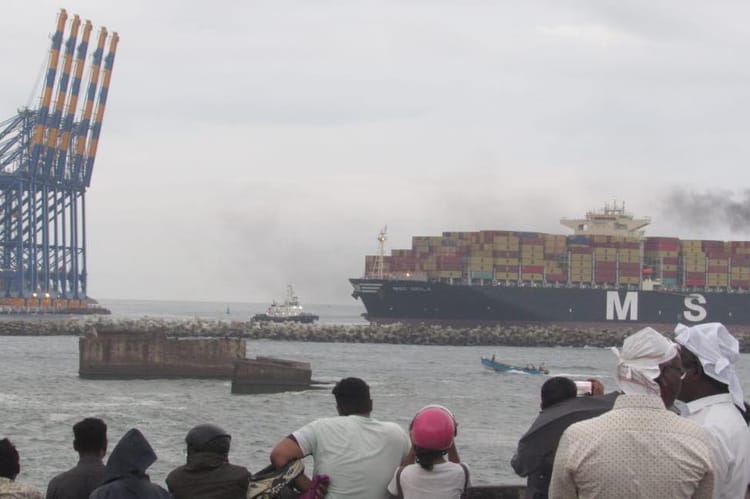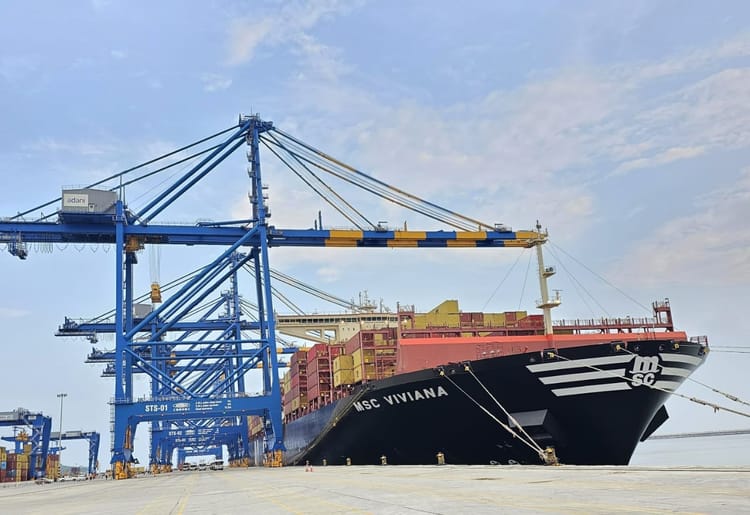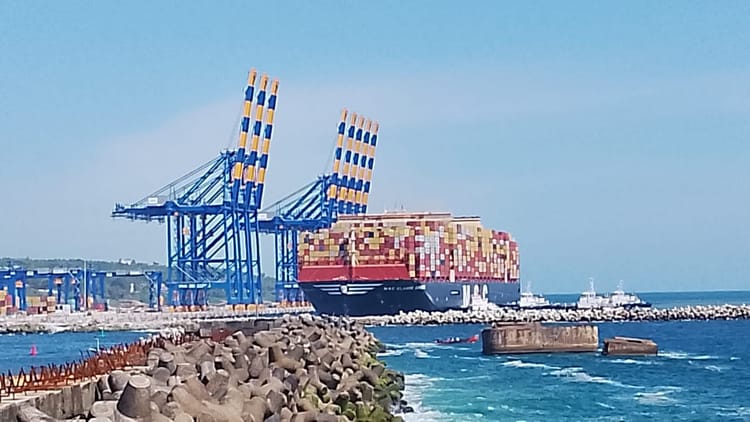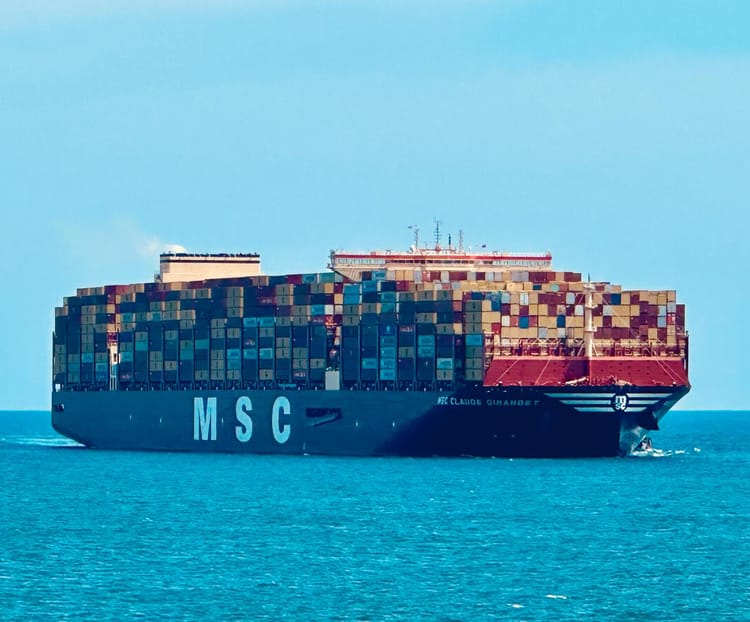Is Adani the actual target of Hindenburg?
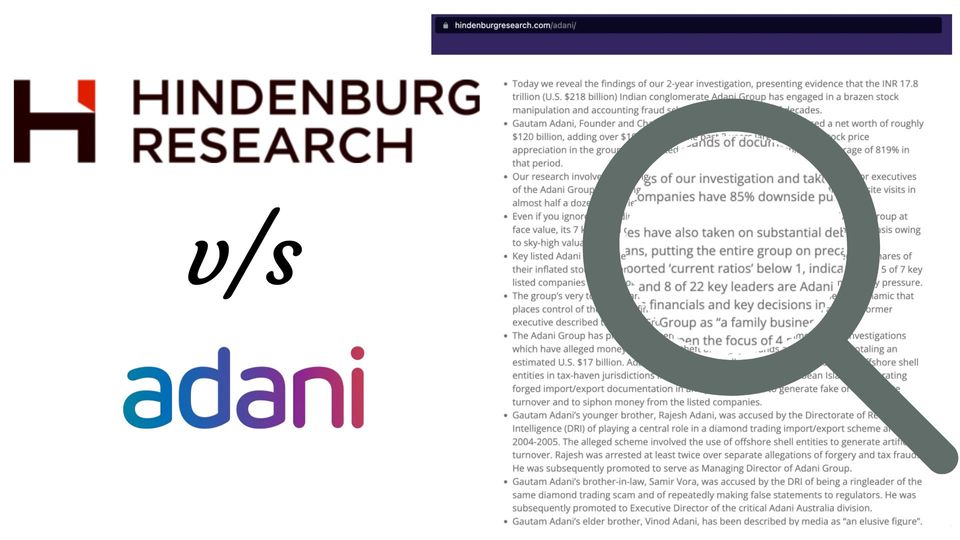
The author of this article is a journalist who, for the past four decades, has been researching and publishing opportunities for a brighter future for India. As the publications were primarily in Malayalam, most of the work has remained unknown to the country and the world. In this quest he learnt about the Nordic’s early child development approach, or how the Panama Canal Authority demonstrated that environment and development can go hand-in-hand, by planting the 5 millionth tree. The list continues from Bhutan's GDH theory of citizen satisfaction to Saudi’s dream city project of NEOM. The motivation behind these research efforts is to see India adopting learnings and important initiatives towards its own growth and development goals. Some of the doubts that were not felt in the earlier studies and readings came up when the author dived deeper into the Hindenburg report. This article aims to put those questions and the rationale behind them out there, in the hope that such queries are clarified.
Hindenburg Research truly deserves appreciation. The process of cleansing the global corporate sector is no small feat, whoever steps in for this task needs to be credited. Launched in 2017, Hindenburg Research claims to have already cleansed 16 corporate entities. Amidst this process, Indian corporate giant Adani Group has also come under trial. The recent revelations made by Hindenburg Research against Adani Group has shocked both investors and laymen alike. But, the picture is complete only when we also examine the Hindenburg group and their interests.
Let's start by referring to the Washington Post’s investigation - “Some corporate executives see activist short sellers as unsavoury actors trying to profit by destroying companies. But others say they can play an important role as actors driven by high financial rewards to expose corporate fraud”[1]. Reaping profits by destroying other institutions, financial gains by exposing corporate frauds - these are concepts that need a bit more context. Let us take the help of Reuters analysis for this. “After finding potential wrong doings, Hindenburg usually publishes a report explaining the case and bets against the target company, hoping to make a profit”[2]. Time Magazine reports, “A short" trade is a way for someone to make money if an investment's price falls. Afterward, if the price of a company's stock or bonds falls because of the negative attention from the report, Hindenburg can profit”[3]. The term “profit” resounds in these publications, while referring to Hindenburg.
Is profit motivated justice, really justice? On the contrary, we would have appreciated Hindenburg if they had tried to expose the corporate culture without seeking any profit. The revelations about Hindenburg unravel even more dangerous interests in addition to their profit interests. What is their business model? “Hindenburg Research works in collaboration with about 10 "investors'' who fund its operations. It prepares its investigation report on a target company in six or more months by going through its public records and internal corporate documents, as well as speaking to its employees. The report is first submitted to the firm's "investors'' allowing them to take a short position before the report is made public. Hindenburg takes a cut of the profits made on that short trade” [4].
Who are Hindenburg’s investors? Does the world know about these investors?
Let us digress a bit and restart with a more recent and familiar context.
At the time of writing this, 68,50,594 people have died worldwide due to COVID-19. In the USA alone, this number stands at 11,32,254. Since 2019 itself, many people have been investigating the origin of coronavirus. A group argued that the virus may have originated from a fish market in Hunan, China, while another argued that the epicentre was the Wuhan Institute of Virology, just 8 miles away. As the arguments progressed, the world witnessed thousands in their death beds struggling for their last breath. The US administration, which faced the most criticism, was quick to pin the blame on China. It constantly approached the World Health Organization (WHO) to initiate an independent investigation on China to bring out the truth. The then US President Donald Trump finally decided to teach the WHO which continuously showed its allegiance to China a lesson, "Congress received notification that POTUS officially withdrew the US from the WHO in the midst of a pandemic" [5]. With this order effective from 6th July, 2021 WHO was set to lose about US$400 million, amounting to 15% of their annual budget. In the days that followed, the revelation that America funded Dr. Shi Zhengli’s (Wuhan Institute of Virology, Chinese Academy of Sciences) research on bat viruses came out, sending shock waves across the world. In 2014, Antony Fauci’s (Health Advisor to President, US) agency had awarded a US$ 3.7 million grant to EcoHealth Alliance, a nongovernmental organisation dedicated to predicting and helping prevent the next pandemic by identifying viruses that could leap from wildlife to humans. The grant, titled ‘Understanding the Risk of Bat Coronavirus Emergence’, proposed to screen wild and captive bats in China, analyse sequences in the laboratory to gauge the risk of bat viruses infecting humans, and build predictive models to examine future risk. The Wuhan Institute of Virology (WIV) was a key collaborator to which EcoHealth Alliance sub-granted almost US$ 600,000. Ofcourse, the United States was defensive when this allegation came out. The argument that the US funded a research that eventually killed its own citizens, is one of the factors that led to the subsequent downfall and defeat of Trump.
You may be wondering what the connection between Hindenburg Research and COVID is. International deals and political manoeuvres are unfortunately, completely unknown to the common man. The commercial interest in finding a vaccine for all types of SARS disease defines the underlying relationship between the governments of countries who outwardly pose as enemies. What we need to know at this point is whether such a relationship is behind Hindenburg Research's revelation.
Depoe Bay on the west coast of America and the island of Ginostra in Italy have been known as the world's smallest port for over 30 years. While these seemingly insignificant ports from marine trade perspective, are world renowned, Vizhinjam port which was conceptualised around the same time, was not even known to many people in Kerala or India. Even before India acknowledged the potential of the Vizhinjam project, two government companies in China, Kaidi Electric Power Company and China Harbor Engineering Company, together with an Indian company called Zoom Developers, a newcomer to the competition, issued a tender for the Vizhinjam project. At that time Zoom Developers was blacklisted in one of the Indian states. It is without such basic diligence that China attempted to enter the port sector in India - without finding even a decent Indian partner for the project valued at INR 4,360 crore project at the time. How did the Vizhinjam project get on China's radar two decades ago, much before it even appeared on the horizon of Indian powerhouses like Adani?
Even wars are redefined now. The era of direct confrontation is now a thing of the past. In today's wars, at times, the victim country is oblivious to a spewing war. Technology has made modern warfare almost contactless. China's Geofen 9-03 satellite, which can provide accurate information within one metre, also passes over India. The Geofen 9-02 Head 4 satellite will help Chinese monitor construction activities around the world under its Belt and Road Initiative from the offices in Beijing [6]. They even have satellites to monitor seas and ships - Chuangxin-5 satellite constellation which consists of 18 Yaogan satellites. This will help the Chinese military track US and other foreign naval deployments. Even the Coast Guard vessels and Adani's construction barges docked at Vizhinjam fishing harbour are within their satellites' views. Their laser cameras ensure that there are no secrets. China can observe what is happening not only on Indian land, but even on its seabed. China's espionage work against India is rarely exposed. The Chinese spy balloon shot down by the US today (February 5th, 2023) is an example of how brazen China's espionage is [7].
China would have been the first country to realise that Vizhinjam is not just another port project. That is why as its construction progresses, new struggles and objections are conspired against it. During the Vizhinjam anti seaport protest, the locals in favour of the port raised anti-China slogans, suspecting the interest of China in derailing the port protest. While people may have not noticed, China used Hindenburg Research to defend themselves with Hindenburg responding by releasing proof including photos to silence those who accused China of having invisible hands in the protests against the Vizhinjam project. They enquired about the Adani Group's relationship with the Chinese national named Chang Chung-Ling. Why is Hindenburg particularly interested in Adani's relationship with this Chinese national?
Establishing that there is a Chinese national within the project is a smart way to counter the narrative that China is working against the Vizhinjam project.
If Vizhinjam was just any other port project, China would not have shown such interest. When the tender for the Vizhinjam project was rejected on security grounds, China was not ready to back down. It is from this point that China began to move its forces with Sri Lanka as its base. China first started construction of the Hambantota port and later took over a terminal at Colombo port. Post that, 665 acres of land has been reclaimed from the sea and China is developing a new financial city in Colombo. China has already invested about US$ 15 billion, the public and private capital combined. China's influence in Sri Lanka has transcended beyond mere business investments to also determine its internal politics. According to reports from Sri Lanka, China has deployed men and money to help Mahinda Rajapaksa win the elections. Almost the same policy has been adopted by China in India's neighbouring island of Maldives. It was China that influenced former Maldivian President Abdullah Yameen to take a strong stand against India. That's how the Indian firm GMR lost out of their airport project. In all of the above cases, we clearly see a common anti-India policy. China views the growing Indian infrastructure as a direct threat to its own future. As the post-Covid world contemplates implementing a China Plus theory, China itself is the first to recognise the danger it poses. The core of the China Plus theory is to withdraw investments that have gone to China and re-invest in some countries that can be seen as alternatives to China. Countries like Vietnam, Malaysia, Indonesia, India and Mexico are in this category. According to Chinese government records, there were 1,040,480 foreign companies operating in China as of last year. What scares China is that if all these companies decide like the Taiwanese companies, it will be a huge setback for China, and at the same time India will make a huge leap. There is a case study explaining this fear.
The protagonist of this case study is Taiwan, which manufactures 80% of the motherboards and laptops sold in the world. The fact that 60% of global communication network equipment and 73% of advanced processing chips are embedded in Taiwan amazes the industrial world. The world would recognize their talent and intelligence in this tiny country when they realise that it has a trade surplus with China. About 4,200 Taiwanese companies are currently operating in China, of which many are considering a relocation. In Taiwan's private sector, there have been growing needs for supply chain diversification after the US-China trade war and the COVID, said Ma Tieying, an Economist with Development Bank of Singapore (DBS). There are even Taiwanese companies that have announced specific decisions beyond such general requirements. They definitely have concrete action plans beyond the broader China Plus strategy. “Foxconn, the world's biggest contract assembler of electronic goods, informed the Taiwan Stock Exchange in September that it would partner with Indian conglomerate Vedanta to establish a semiconductor factory in Gujarat worth US$ 118.7 million”[8]. At one stage, 50% of the foreign investment that Taiwan pulled out of China went to India, which is a big indicator that China sees it. Anticipating this, China is preparing some stopovers so that companies leaving it do not go to India, one of which is the 565-acre Industrial Park adjacent to Sri Lanka’s Hambantota Port. If investors are coming to India ignoring such Chinese temptations, there are many other reasons. “Taiwanese firms are 'eager' to run factories in India as its supply chains improve” says Estela Chen, New Delhi based Taiwanese official. It is a fact that positive changes in the supply chain will attract more investments. Apart from that, the availability of a unique market is an attractive factor for entrepreneurs. The fact that 50 crore people with purchasing power is another factor that attracts many people. There is no doubt that many other countries and companies will follow Taiwan's lead. It is only with the disruption of India’s supply chain that this influx can be stopped. This is one goal of the Hindenburg report released on January 24, 2023. Even the timing chosen to release the report has to be the result of painstaking calculations. Adani Group had decided to launch an FPO of INR 20,000 crore for the development of projects including Adani Ports. The 13 ports/terminals in the country operated by Adani are key links in India's supply chain. Adani Group handled 312 million tonnes of cargo in 2022. With these ports accounting for 24% of the national port capacity and handling 500 million tonnes of cargo within the next two years (2025), China is on track to disrupt this. Apart from that, Adani's global growth in Colombo and Haifa (Israel) port also needs to be noted. That's why someone decided that now is the right time to upset Adani's apple cart.
At first glance, we may see this as a move against Adani. But from a global perspective, things are not so simple and transparent. More than a move against a corporate tycoon, this is a planned attack on a country. But by presenting it as the lies, corruption of a corporate tycoon, Hindenburg report has successfully garnered support from within India itself, the proof of which lies in the demands for Supreme Court-led and Joint Parliamentary Committee-led investigations. Let us bring to the attention of those who make such demands. These days we see the hustle and bustle of a global competition. China has strengthened its global assets as it seeks to disrupt India's supply chain. Apart from Antarctica that doesn’t have a port, China is establishing or taking over existing ports in over 100 countries. They control 80% of the world's ports. They have established trade relations with 120 countries. According to an earlier estimate from 2014, China has already invested US$ 123.1 billion in these countries. Many could be contracts to import rare minerals into China. About 18,500 Chinese people run 29,700 firms in 186 countries. China received US$ 180.96 billion in Foreign Direct Investment (FDI) in 2021. This ground-level preparation by China with clear planning has given them an advantage over many other countries. They will not easily give up the benefits of the globalisation reforms that began in the late seventies. India is just behind China, which is heading to the first position in global production. PwC predicts that China, which accounts for 18% of global GDP (PPPs) as of 2016, will increase that to 20% by 2050, and that India, which currently accounts for only 7%, will jump to 15%[8]. What worries China is that there are many ammunitions in the quiver of Indian corporations like Adani that can overcome the 5% difference between China and India. The fact that the 5% growth that India is likely to achieve will come at the expense of China will also add to their heartache. It is highly likely that more, and newer Hindenburg reports may come out.
Let me conclude this little investigation by looking at the very first sentence of the Hindenburg report of 24th January. “Today (January 24th, 2023) we reveal the findings of our 2-year investigation, presenting evidence that the INR 17.8 trillion (US$ 218 billion) Indian conglomerate Adani group has engaged in a brazen stock manipulation and accounting fraud scheme over the course of decades”.[9]
From this we understand that Hinderburg’s study of the Adani Group was initiated in January 2021. Now let's look into another sentence from an interview of Hindenburg CEO Nathan Anderson to CNN Business on June 25, 2021 - "Because Hindenburg doesn't employ an army of workers, Anderson said the Company has decided to focus more on smaller and mid-sized companies instead of trying to figure out if a widely held mega-cap tech stock is worth shorting.”[10]
Some questions have to be raised from these statements.
1. At what point, post June 2021, did Hindenburg change its stance of evaluating small share value companies?
2. If Hindenburg in fact started the study post June 2021, then at the outset shouldn't we consider its claim of studying the Adani Group for 2 years wrong?
3. How did a company with only 5 full time employees, including Anderson, manage to access and research the financial books of a US$ 218 billion company so accurately?
4. On the doubts over capabilities of Adani's auditors, given that a small group of just five individuals from Hindenburg was able to uncover errors in the accounts of a US$ 218 billion organisation, is it not possible for the 11-person team and 4 partners at Shah Dhandharia Auditors to thoroughly examine the accounts of Adani Enterprise and Adani Total?
5. When did Hindenburg's own resources and capacity grow enough to study a corporate giant as opposed to its usual small and medium sized targets?
6. As Anderson himself recognises that an “army of workers” are needed to execute a study of this size, did Hindenburg hire or contract employees for the purpose of the Adani Group study?
7.What is the reason behind this sudden exposé of a mega-cap tech stock company as opposed to Hindenburg’s usual focus of study?
My interest and research in the subject begins only at the point where the Hindenburg report controversy would hinder the construction of India's first transshipment port. But, Hindenburg seems to have studied that a little deeper! In terms of unrestricted cash, Adani Ports is the only listed entity with significant reserves at INR 86 billion (US$ 1.05 billion) according to its FY2022 Annual report (Pg. 515). It is also the only listed entity which seems capable of consistently generating substantial positive cash flow: approximately INR 52 billion (US$ 640 million) as of March 2022 (Pg. 141).
If your report also affects the operation of Adani Ports, which you yourself claim to be operating in a systematic way, isn't that a huge disservice you are doing to the Adani group and to this country? Not only this, but aren’t you contributing to the destruction of a growing Indian supply chain? Whose interest is this? It seems that all your inquiries and accusations crumble before Time magazine's single question: What does Hindenburg get out of this?
"It can make money."[3] I can only interpret Hindenburg’s noble act of cleansing the stock market under the pretence of building its own empire as nothing but first-class espionage.
I would like to believe that all the above mentioned facts are false and that the Hindenburg report is completely true and fair. As a humble journalist, I understand the hard work and dedication it takes to bring out such facts, and I respect Hindenburg for it. But before that a request to Hindenburg: While you are on your mission to expose and destroy the corporate vultures, can you do a favour to the world and reveal who those 10 'good' investors behind you are? That alone is not enough, this picture will be complete only if you reveal how much of this 'a lot of money' was earned by those 10 investors and what is the source of their wealth. Then I will withdraw all my allegations unconditionally and apologise to you.
References
- Washington Post. (2023, January 28). Adani, Hindenburg, Anderson: Short Selling. Retrieved from https://www.washingtonpost.com/business/2023/01/28/adani-hindenburg-anderson-short-selling/
- Reuters. (2023, February 1). Hindenburg bet against India's Adani puzzles rival US short-sellers. Retrieved from https://www.reuters.com/world/india/hindenburg-bet-against-indias-adani-puzzles-rival-us-short-sellers-2023-02-01/
- Time. (2023, February 01). What is Hindenburg Research, the Firm Accusing India's Adani Group of Fraud? Retrieved from https://time.com/6251840/hindenburg-research-explained/
- New York Magazine. (2022, January 20). Last Sane Man on Wall Street. Retrieved from https://nymag.com/intelligencer/2022/01/nathan-anderson-hindenburg-research-short-selling.html
- BBC. (2021, June 25). Coronavirus: Trump moves to pull US out of World Health Organization. Retrieved from https://www.bbc.com/news/world-us-canada-53327906
- Geospatial World. (n.d.). Catching Up with Neighbor. Retrieved from https://www.geospatialworld.net/prime/special-features/catching-up-with-neighbor/
- Reuters. (2023, February 4). Biden says US is going to take care of the Chinese balloon. Retrieved from https://www.reuters.com/world/us/biden-says-us-is-going-take-care-of-chinese-balloon-2023-02-04/
- South China Morning Post. (2022, November 3). China-US tensions force Taiwanese tech firms to consider plan B in India or Vietnam. Retrieved from https://www.scmp.com/economy/article/3198171/china-us-tensions-force-taiwanese-tech-firms-consider-plan-b-india-or-vietnam
- Hindenburg Research. (2023, January 24). Adani. Retrieved from https://hindenburgresearch.com/adani/
- CNN. (2021, June 25). Meet the man behind Hindenburg Research, the short-seller taking on tech giants. Retrieved from https://edition.cnn.com/2021/06/25/investing/hindenburg-research-short-seller-nate-anderson/index.html
The post was originally written by the author in Malayalam and later translated to English.
This article © 2023 by Motherport News is licensed under CC BY 4.0
